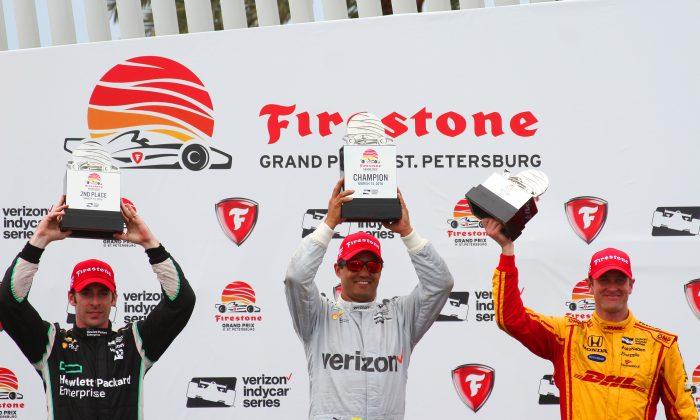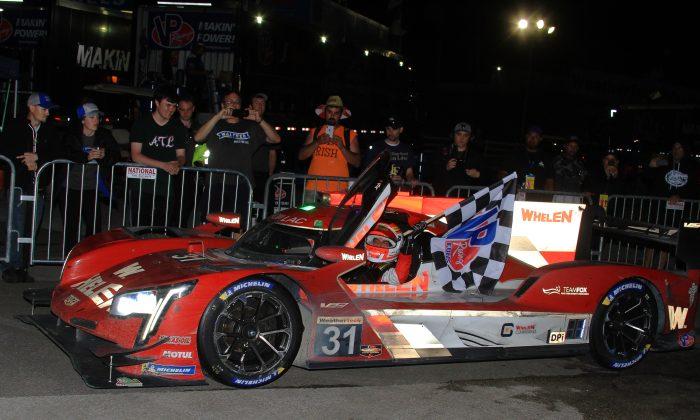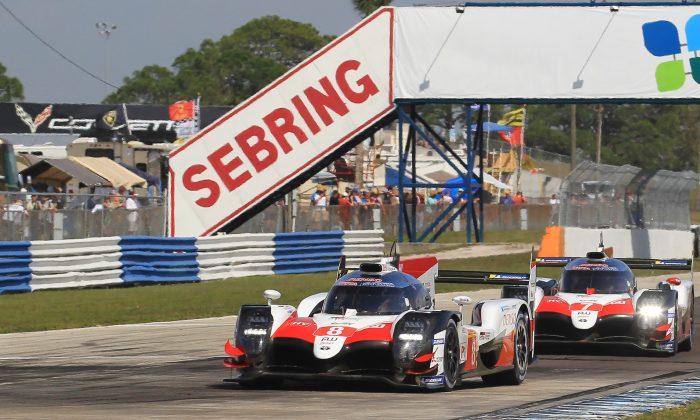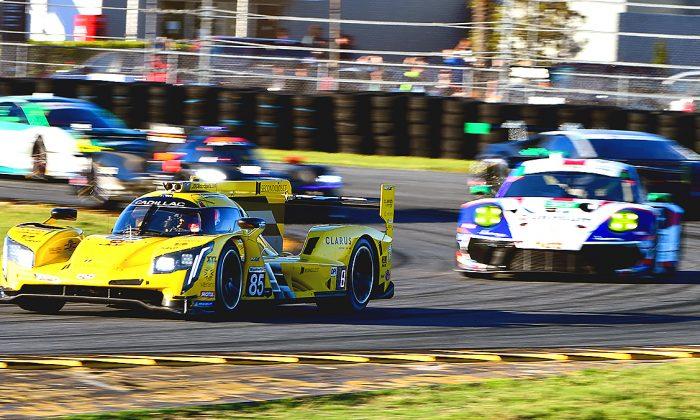ST. PETERSBURG, Fla.—The Verizon IndyCar Series, America’s premier open-wheel racing series, opened its 2016 season with the Firestone Grand Prix of St. Petersburg. Like last year, Penske Racing’s Will Power won the pole, his team mate Juan Montoya took the win, there were two Penske drivers on the podium, and the Chevrolet-powered cars proved to be quicker than Honda’s offerings.
Penske Racing has always done well on the streets of St. Pete: the team has won four of the last five races and eight of the twelve that have run here. This makes it difficult to tell if Chevrolet’s engine and aerokit is better than Honda’s (as was the case throughout last season) or if Penske is just better prepared for St. Pete than any other team.
Whatever the case, Penske and Chevrolet made strong statements at St. Pete, as did Juan Montoya. After returning to IndyCar in 2014 after 13 years in F1 and NASCAR, The 40-year-old Colombian driver proved that he still has the speed which earned him the championship in 1999, his rookie year, and a win in the Indy 500 in his first attempt in 2000.
Montoya won one race in 2014 and finished fourth in the points, while still learning the new car. He won two races in 2015—St. Pete, and his second Indy 500—and finished second in the points. His repeat at St. Pete proves he is ready to continue his quest for another IndyCar title.

Montoya won one race in 2014 and finished fourth in the points, while still learning the new car. He won two races in 2015—St. Pete, and his second Indy 500—and finished second in the points. His repeat at St. Pete proves he is ready to continue his quest for another IndyCar title.
Juan Montoya is also a fan favorite, at least at St. Pete. There is always a large Colombian contingent chanting his name and waving flags when he appears in Victory Circle. Having popular drivers in the series doesn’t affect the racing, but it sure helps the series’ bottom line.

Odds in Penske’s Favor
Penske Racing has always been a powerhouse in IndyCar. This year’s line-up: Montoya, Will Power, Helio Castroneves, and Simon Pagenaud—is almost comically strong. While there are plenty of fast drivers on good teams, no single team has so much talent and expertise to draw on. While Roger Penske will let his drivers race each other, everything any driver or crew learns is shared among the team mates.
Target-Chip Ganassi, which for many years was Penske’s equal and nemesis, has four-time champion Scott Dixon and champion and Indy 500 winner Tony Kanaan. Andretti Autosports has Ryan Hunter-Reay, also a 500 winner and past champion. No team has the kind of driver firepower that Penske boasts, and few have such a finely tuned organization.

As Simon Pagenaud put it, “When you win a race in IndyCar, it’s when you’ve done everything perfect.” Penske precision is legendary: the fanatic attention to detail, the rigorous discipline, the wealth of information constantly accessed to find any edge.
Yes, the team, and its leaders, have made the occasional mistake—Will Power would have three or four championships by now if the team was really perfect—but Penske Racing has enough talent to triumph frequently, to tilt the odds in the team’s favor.
Penske also has drivers talented enough to overcome tough situations: Juan Montoya drove most of the St. Pete Grand Prix with broken steering, the result of smacking the wall in the closing moments of morning warm-up.
The steering got worse as the race wore on, and finally, in the closing laps, something broke in a big way. Montoya had to turn the wheel 90 degrees to the right to get the front tires to move—but he adapted. He had five seconds’ lead, he had a team mate behind him, and he had saved his Push-to-Passes, so he could rocket down the straights and ease through the corners through the final three laps and maintain first place.
Penske swept qualifying, with Will Power breaking the record he set while winning pole last year. In fact, Penske Racing duplicated the front of the 2015 St. Pete Grand Prix, with Simon Pagenaud, Helio Castroneves, and Juan Montoya scoring spots two through four.
Will Power had to sit out the race due to a mild concussion sustained during Friday morning practice. He barely made it through qualifying—which makes his performance all the more remarkable.

Montoya and Pagenaud Fastest in the Field
Simon Pagenaud led a rare clean start—Turn One at St. Pete has a history of inciting first-lap wrecks as it narrows from an airport runway down to two lanes. This year the whole field negotiated the first turn, and in fact managed the first 46 laps of the race without a caution—a caution caused by Luca Filippi hitting Marco Andretti—in Turn One.

After nine laps of clean-up, track-sweeping, and pit stops, the race restarted on lap 56—but as they say, cautions breed cautions. This time the caution was caused by a five-car pile-up in Turn Four, involving Graham Rahal, Oriol Servia, Sébastien Bourdais, Charlie Kimball, and Carlos Munoz. Corner workers attacked the scene, creating a narrow path through the debris field to prevent a red flag, and after only five laps the race was ready to resume for the third time.
Pit strategy had put Conor Daly in the lead, but it took Juan Montoya only a single lap to get past him. The Penske driver stayed out front—except to swap with Ryan Hunter-Reay during pit stops—for the rest of the day. Pagenaud came home 2.3 seconds behind his team mate, with the remaining Penske driver, Helio Castroneves, fourth.

Pagenaud restarted ahead of Montoya, but, “Montoya is an old dog. He found a little good trick on me,” Pagenaud explained.
“Unfortunately I had a lot of wheel spin compared to last year. I decided to be aggressive on the restarts. Maybe I was too close to T.K. I think it took quite a bit of aerodynamics out of my car. Had a lot of wheel spin, didn’t go forward. Great job on him to get me.”
By finishing third, Hunter-Reay broke up the Penske-Chevy podium sweep—which he recognized as a significant accomplishment.

“We got everything out of it today. There was nothing left in the car. Had some good battles out there today. Helio really dive-bombed me there at one point and hit Dixon, almost turned him around. It was really nice to get by him at the end for the podium. That was a small, tiny little victory for us.
“Just to be on the podium with the Penske boys today is a big accomplishment because they’ve been the class of the field here for many years.”

Helio worked hard to make it a Penske podium. He attacked RHR in Turn One, and the two raced side-by side through two corners, with the Andretti driver getting the edge. Then Castroneves pulled a dangerous dive-bomb maneuver into Turn Four, shooting past Hunter-Reay and bouncing hard off Ganassi driver Scott Dixon. Castroneves was able to keep going, but later lost third to Hunter-Reay anyway.
Ryan Hunter-Reay praised the new Honda aerokit but also pointed out its shortcomings. (Chris Jasurek/Epoch Times)
Chevrolet Ahead of Honda Already?
Chevrolet joined Honda as an IndyCar engine supplier starting in 2012 and has powered three series champions since. It’s 2015 aerokit was universally considered to be better than Honda’s.
Both engine suppliers tweaked their aerokits over the off-season; so far it seems Chevy was more effective. According to drivers, both kits offer better downforce than last year’s models; the Chevy package seems to be better balanced and more efficient.
After the race Juan Montoya described the difference between last year’s kit and this year’s: “Last year we had a really fast car, but it was hard on rear tires. Today I could get on the gas really hard all day long, and the tires were 100% behind me. That was really nice.”
Simon Pagenaud agreed that the new aero package, with added downforce, helped keep the rear tires alive longer. “Our package is just more stable in general,” he said.

Honda has some ground yet to gain. Ryan Hunter-Reay, the top Honda-powered finisher in third, explained it at the post-race press conference: “We were half a second off the Penskes in qualifying. That’s not acceptable.”
Still the Honda kit has improved, according to Hunter-Reay. “Last year I think we qualified 10th or 12th or something. I’m not even sure. It was a sidenote. This year we made the Fast Six. It’s definitely better,” he explained.
“The new package, what it does best is it doesn’t surprise you. Last year’s package, it was constantly trying to throw you into the wall. You couldn’t really get on top of it. You always had to stay at 90%. This one you can drive at 100%, at least you know what it’s going to do. Somewhat predictable.”

This raises the question: Is Chevrolet going to dominate IndyCar again, as it did in 2015? Last year Honda won six of 16 races; Chevy won the rest, and all the pole positions. Only four Honda drivers: James Hinchcliffe, Carlos Munoz, Ryan Hunter-Reay, and Graham Rahal, from three teams: Schmidt Peterson, Andretti, and Rahal Letterman Lanigan—won for Honda.

Five drivers from four teams won with Chevrolets: Juan Montoya and Will Power from Penske, Target-Ganassi’s Scott Dixon, Josef Newgarden from CFH, and KV Racing’s Sébastien Bourdais.
Penske had three wins; no other team managed more than two. And Scott Dixon, driving Target-Chip Ganassi’s Chevy-powered #9 car, took his fourth championship.

Honda is supposed to come out with a new engine featuring better drivability at some time in the next few races—but that won’t fix the problem of a less-efficient aerokit providing less downforce. Hunter-Reay said he burned the rear tires off his Andretti Honda holding onto third, while both Pagenaud and Montoya felt they had life left in their tires. Montoya also said he was able to follow Pagenaud through the first half of the race while saving fuel.

As Ryan Hunter-Reay and Graham Rahal proved last year, an inspired driver in a Honda-powered car can still win races—and there are enough good drivers and in the field to keep the show exciting. Jack Hawksworth was particularly fast in his Foyt Honda in the early practice sessions, and Mikhail Aleshin in the Honda-powered SMP/Schmidt machine was very quick during the race. He started 17th and finished fifth, advancing twelve positions to be the biggest mover of the race.
Neither a Chevrolet nor a Penske walkover is even near certain. Still both the team and the manufacturer made strong statements on opening day.
Up Next: Phoenix Grand Prix
IndyCar heads to Phoenix for its next race—a completely different venue, a low-banked (8-11 degrees) one-mile tri-oval where IndyCar hasn’t raced since 2005; and the series has never raced there in the track’s current configuration.
This means every team will be starting from scratch—no one should have an edge in set-up because there is no past data to review.
Phoenix will display how well each manufacturer’s latest aerokit works on a short oval. Possibly Honda will have an edge there as Chevy did at St. Pete. Also, Phoenix will be a night race. While St. Pete was hot and humid, Phoenix could be cooler, and dry.
Of the existing crop of IndyCar drivers, only Tony Kanaan and Helio Castroneves have won at Phoenix, and that was when the track was narrower and tighter. Target-Ganassi and Penske might have some data they could share from their NASACR teams, but whether any of that would even vaguely relate to IndyCar is a mystery.
Basically, fans couldn’t ask for a greater contrast or a better test for the teams. Phoenix opens the oval-track season, so it is almost like a second first race.
Tickets and information can be found online at PhoenixRaceway.com and IndyCar.com






